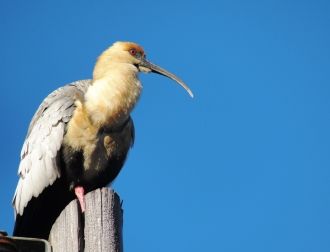
Publisher:
Bonnie King
CONTACT:
Newsroom@Salem-news.com
Advertising:
Adsales@Salem-news.com

~Truth~
~Justice~
~Peace~
TJP
Jul-09-2010 15:20

 TweetFollow @OregonNews
TweetFollow @OregonNews
The Black -Faced Ibis, Bandurria, Theristicus Melanopis
Gail Parker Salem-News.comWithin my barrio and around the pueblo, are various bands that tend to sleep in the same roosting spots every night.
 The Black -Faced Ibis, Bandurria, Theristicus Melanopis Photos by Gail Parker for Salem-News.com |
(PATAGONIA, Argentina) - For me, the bird that symbolizes Patagonia is not my old nemesis the tero - who tried to spoil my pea crop last spring - but the goose-sized bandurria, or black faced ibis.
Morning and evening the plastic horn honking of the bandurrias tells me when it is time for their ritual gathering. A band of 26 roosts across the road in the bosque, and they announce their intentions loudly.
The roosting call and the flight call are distinct from each other.
Throughout the day, this large blue gray bird with its curved beak, scarlet red legs and peach colored throat hunts worms and grubs, insects and larvae, in the nearby pastures and often in my garden, teasing the dogs and ignoring the pretentious cats who stalk them.
The black faced ibis is large, some 30" (750 mm) tall; the sexes are alike. The curved beak is black with a green point. Part of the face, the throat and wattle are naked of feathers and black, the eyes are red, the forehead and crown and back of the head are chestnut. The rest of the head and neck are creamy white to buff.
The gray back, which looks blue in the sunlight, has brown feather margins, gray sides, and the tail and rump are black with green iridescence.
The wings are ash gray to silver. The chest is ocher and whitish with a band of gray/brown below the base of the neck and across the front.
The abdomen, flanks and the feathered parts of the legs are black. The local subspecies is slightly more reddish on the head, and a little less silver on the wing.
This ibis is found from Ecuador south to Tierra del Fuego and in the steppes, in forests, meadows, marshes, parks and agricultural lands. They are seen in groups as few as two or three pairs or in bands as large as fifty individuals.
Though they migrate to the Pampas from colder zones during the austral winter, they remain in northern Patagonia year round. They are easily recognized by their size, coloration and long curved bill, which they poke around in the soil.
Besides worms and so forth, bandurrias eat some vegetation and all classes of insects as well as scorpions, crustaceans, amphibians and the occasional rodent.
Last week when Senora Edith, the only sister of the famous Kovacs bird family, told me that she has seen bandurrias eating baby teros or lapwings, I was saddened to learn that my favorite Patagonian bird was the culprit.
One always hates to hear bad news about a friend, but considering that predation is a natural instinct, I try to forgive them for seeing the tiny balls of fluff as dinner, rather than innocent baby lapwings... After all, I myself have thought of calling out the militia over the destruction of my pea patch by their parents.
Within my barrio and around the pueblo there are various bands that tend to sleep in the same roosting spots every night.
When some 60-year-old cypress trees (native evergreen) were felled to make way for development last month, my local population of 12 black-faced ibis more than doubled.
The newcomers seem to have settled in without much guff about the legality of their immigration to Barrio Arrayanes.
And though my garden offers an abundance of worms and other grubby meals, only one family of three has claimed it as their domain for the past few years, hanging out and doing a bit of ”bird watching”.
One in particular enjoys the top of the telephone pole in front of the house, and when the rest of the larger band are attending bandurria convocation at sunrise and sunset, this wise old one refrains from the liturgy, preferring to let go droppings as close as possible to my annoyed German shepherd.
Bandurria call: xeno-canto.org/america/species.php?query=sp:222.00
=============================================
 Gail Parker is a writer and photographer who lives in Argentina. She and her lifetime mate and husband Eddie Zawaski, who also writes for Salem-News.com, are former residents of Oregon, Gail has a great eye for memorable photos in this unique place called Patagonia. Her observations from this amazing wonderland of nature are a fun and welcome addition to our story flow.
Gail Parker is a writer and photographer who lives in Argentina. She and her lifetime mate and husband Eddie Zawaski, who also writes for Salem-News.com, are former residents of Oregon, Gail has a great eye for memorable photos in this unique place called Patagonia. Her observations from this amazing wonderland of nature are a fun and welcome addition to our story flow.
Watch for Gail's wonderful coverage of the birds of Patagonia in future stories and photojournals here on Salem-News.com.
Articles for July 8, 2010 | Articles for July 9, 2010 | Articles for July 10, 2010

Quick Links
DINING
Willamette UniversityGoudy Commons Cafe
Dine on the Queen
Willamette Queen Sternwheeler
MUST SEE SALEM
Oregon Capitol ToursCapitol History Gateway
Willamette River Ride
Willamette Queen Sternwheeler
Historic Home Tours:
Deepwood Museum
The Bush House
Gaiety Hollow Garden
AUCTIONS - APPRAISALS
Auction Masters & AppraisalsCONSTRUCTION SERVICES
Roofing and ContractingSheridan, Ore.
ONLINE SHOPPING
Special Occasion DressesAdvertise with Salem-News
Contact:AdSales@Salem-News.com




Terms of Service | Privacy Policy
All comments and messages are approved by people and self promotional links or unacceptable comments are denied.
gp July 18, 2010 5:32 am (Pacific time)
July 18, Sad postscript: One of the old snags came down in the middle of the night 3 days ago. When there sleep was disturbed that night, the bandurrias decided enough was enough and all twenty six have found other lodgings. Despite the loss of 2 trees to the axmen and another snag going down earlier, I am hoping that they will return to this roost. But since they are such creatures of habit, I suppose they will stay in the new trees they have discovered. For now, I have to content myself with hearing them somewhat distantly. Sad.
Linda Place July 9, 2010 4:24 pm (Pacific time)
I love the banduria as well.I can't say that their call is lovely but as you say..they let one know the time of day with reliability. Your photos of your feathered neighbors are a delight, especially the stalking kitty photo. Thanks for featuring this comical winged character.
[Return to Top]©2025 Salem-News.com. All opinions expressed in this article are those of the author and do not necessarily reflect those of Salem-News.com.